In this edition:
* Starliner Brings Another Ham to ISS
* Q&A Session with AMSAT Engineering
* Voyager 1 is Back To Life, But For How Long?
* AMSAT Mail Alias Service to End August 1, 2024
* The 2024 AMSAT Field Day Rules
* Changes to AMSAT-NA TLE Distribution for June 14
* ARISS News
* Upcoming Satellite Operations
* AMSAT Ambassador Activities
* Satellite Shorts From All Over
The AMSAT News Service bulletins are a free, weekly news and information service of AMSAT, the Radio Amateur Satellite Corporation. ANS publishes news related to Amateur Radio in Space including reports on the activities of a worldwide group of Amateur Radio operators who share an active interest in designing, building, launching and communicating through analog and digital Amateur Radio satellites.
The news feed on http://www.amsat.org publishes news of Amateur Radio in Space as soon as our volunteers can post it.
Please send any amateur satellite news or reports to: ans-editor [at] amsat.org
You can sign up for free e-mail delivery of the AMSAT News Service Bulletins via the ANS List; to join this list see: https://mailman.amsat.org/postorius/lists/ans.amsat.org/
ANS-168 AMSAT News Service Weekly Bulletins
DATE 2024 June 16
Starliner Brings Another Ham to ISS
Working around multiple helium leaks and thruster problems, the crew of Boeing’s Starliner spacecraft wrapped up a challenging rendezvous and a delayed-but-successful docking with the International Space Station Thursday in a major milestone for the new ship’s first piloted test flight.
With commander Barry “Butch” Wilmore and co-pilot Sunita Williams, KD5PLB, monitoring the Starliner’s automated approach, the Starliner’s docking mechanism engaged its counterpart on the front of the station’s forward Harmony module at 17:34 UTC on June 8 as the two spacecraft were sailing 260 miles above the Indian Ocean.
After extensive checks to verify an airtight seal, hatches were opened and Wilmore and Williams floated into the lab complex to an enthusiastic welcome from the seven Expedition 71 crew members: cosmonauts Oleg Kononenko, RN3DX, Nicolai Chub and Alexander Grebenkin, RZ3DSE, along with NASA astronauts Matthew Dominick, KCØTOR, Michael Barratt, KD5MIJ, Jeanette Epps, KF5QNU, and Tracy Dyson.
Wilmore and Williams plan to spend about a week aboard the outpost before returning to Earth aboard the Starliner. While they’re there, the station crew will install a replacement urine processor pump module that was loaded aboard the Starliner at the last minute to fix the lab’s water recycling system and allow normal use of the toilet in the U.S. segment of the station.
Running years behind schedule after multiple problems that cost Boeing some $1.4 billion to correct, the Starliner was launched Wednesday with a known helium leak in the system used to pressurize the spacecraft’s propulsion system. Launch had been delayed a month, in part because of work to confirm the ship could safely be launched with the leak as is.
After reaching orbit, two more helium leaks developed that prompted flight controllers to close valves leading to the affected plumbing, or manifolds, while they analyzed leak rates and potential work arounds. Closing the manifolds took down five of 28 reaction control system jets in the ship’s service module and three of 20 more powerful “OMAC” thrusters.
Docking had to be delayed because five RCS jets were “deselected” by the capsule’s flight software when telemetry showed they were not performing exactly as expected. It was unclear if there would be sufficient maneuverability for the docking to proceed.
Throughout the process, Wilmore flew the Starliner manually, holding position about 650 feet from the space station. When ground teams concluded the spacecraft had enough thruster redundancy to proceed, the Starliner’s automated control system took over and flew the ship in for a problem-free docking.
As if the team hadn’t had enough problems to deal with, a fourth and a fifth helium leaks were detected after docking. In any case, per standard procedure, flight controllers closed all the Starliner’s helium manifolds after the linkup to prevent any residual leakage while attached to the station.
Despite the leaks, NASA officials said more than enough helium remains on board to ensure a safe return to Earth at the end of a normal-duration or even extended mission.
On June 14, NASA and Boeing teams pushed back the target undocking and landing date for the Starliner spacecraft from the International Space Station by four days. They shifted from June 18 to now no earlier than June 22.
The reason for the extended stay is in part due to a need to gather more information about the Starliner capsule with the benefit of having an astronaut crew assigned to study aspects of the spacecraft with additional detail.
The helium leaks are all located in the Starliner’s drum-shaped service module, which is discarded to burn up in the atmosphere before the crew capsule re-enters for landing. Thus, there is no possibility of post-flight analysis of the problems.
[ANS thanks Spaceflight Now for the above information]
The 2024 AMSAT President’s Club coins are here now!
Help Support GOLF and Fox Plus
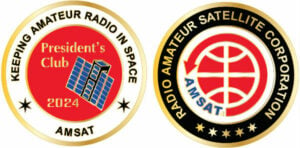
Join the AMSAT President’s Club today and help
Keep Amateur Radio in Space!
https://www.amsat.org/join-the-amsat-presidents-club/
Q&A Session with AMSAT Engineering
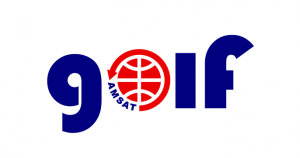 AMSAT Vice President – Engineering, Jerry Buxton, NØJY, will host Q&A “social gathering” live streams on YouTube and Twitch, as he mentioned in his Hamvention “They Cancelled All My Flights” video. This is an opportunity to follow up with Jerry on developments with GOLF, FoxPlus, and other projects. Come by and chat a question or comment for discussion on your choice of the platforms:
AMSAT Vice President – Engineering, Jerry Buxton, NØJY, will host Q&A “social gathering” live streams on YouTube and Twitch, as he mentioned in his Hamvention “They Cancelled All My Flights” video. This is an opportunity to follow up with Jerry on developments with GOLF, FoxPlus, and other projects. Come by and chat a question or comment for discussion on your choice of the platforms:
- Friday June 21 at 19:00 – 21:00 UTC (generally for UK-EU-etc. time zones)
- Saturday June 22 at 00:01 – 02:00 UTC (Friday evening-night in the Americas)
- Saturday June 22 at 19:00 – 21:00 UTC (anybody free that afternoon)
- Sunday June 23 at 00:01 – 02:00 UTC (Saturday evening-night in the Americas)
[ANS thanks Jerry Buxton, NØJY, AMSAT VPE, for the above information.]
Voyager 1 is Back To Life, But For How Long?
NASA engineers have succeeded in breathing new life into Voyager 1, the spacecraft launched in 1977 and once again communicating after it went silent seven months ago. But now comes another challenge: Keeping Voyager 1 scientifically useful for as long as possible as it probes a realm where no spacecraft has gone before.
Voyager 1 and its twin, Voyager 2, are treasured at NASA not only because they have sent home astonishing images of the outer planets, but also because in their dotage, they are still doing science that can’t be readily duplicated.
They are now in interstellar space, far beyond the orbits of Neptune and Pluto. Voyager 1 is more than 15 billion miles from Earth and Voyager 2 nearly 13 billion miles. Both have passed the heliopause, where the “solar wind” of particles streaming from the sun terminates.
“They’re going someplace where we have nothing, we have no information,” NASA Deputy Administrator Pam Melroy said. “We don’t know anything about the interstellar medium. Is it a highly charged environment? Are there a lot of dust particles out there?”

Ed Stone, who guided the mission from 1972 until 2022, died on June 9. (Luis Sinco/Los Angeles Times/Getty Images)
Even as the Voyagers continue their journeys, engineers and scientists at the NASA Jet Propulsion Laboratory in Pasadena, Calif. are mourning the loss of Ed Stone, the scientist who guided the mission from 1972 until his retirement in 2022. Stone, a former director of JPL, died June 9 at the age of 88.
Voyager 1 has four scientific instruments still operational in this extended phase of its mission, but it suddenly ceased sending intelligible data on Nov. 14. A “tiger team” of engineers at JPL spent the ensuing months identifying the problem — a malfunctioning computer chip — and restoring communication.
What no one can change, though, is the mortality of a spacecraft with a limited power supply. Voyager 1 is running on fumes, or, more precisely, on the dwindling power from the radioactive decay of plutonium. The Voyagers use a radioisotope thermoelectric generator. But an RTG doesn’t last forever. Voyager 1 and Voyager 2 will eventually go silent as they continue to cruise the galaxy.
“At some point, we’ll have to start turning off the science instruments one by one,” project scientist Linda Spilker said. “Once we’re out of power, then we can no longer keep the spacecraft pointed at the Earth. And so [the Voyagers] will then continue on as what I like to think of as our silent ambassadors.”
In a sense, this is all a bonus because the primary mission for the two Voyagers was the exploration of the outer planets. Both visited Jupiter and Saturn, and Voyager 2 went on to Uranus and Neptune in what was known as the “Grand Tour” of the outer solar system, enabled by a rare orbital arrangement of the planets. The Voyagers delivered spectacular close-up images of the outer planets, and the mission ranks among NASA’s greatest achievements.
The gravitational slingshot from the planetary encounters sent Voyager 1 out of the elliptical plane of the solar system and did the same to Voyager 2 in a different direction.
About four years ago, Voyager 1 encountered something unexpected — a phenomenon scientists have dubbed a pressure front. Jamie Rankin, deputy project scientist, said the instruments on the spacecraft picked up a sudden change in the magnetic field of the interstellar environment, as well as a sudden increase in the density of particles.
What exactly caused this change remains unknown. But NASA scientists are eager to get all the data flowing normally again to see whether the pressure front is still detectable.
[ANS thanks The New York Times for the above information]
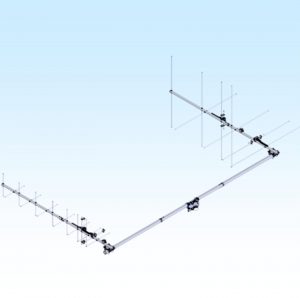
Need new satellite antennas?
Purchase M2 LEO-Packs from the AMSAT Store.
When you purchase through AMSAT, a portion of the proceeds goes towards
Keeping Amateur Radio in Space.
https://amsat.org/product-category/hardware/
AMSAT Mail Alias Service to End August 1, 2024
A long-standing member service, the AMSAT Mail Alias Service is scheduled to end on August 1, 2024. A mail alias on AMSAT.ORG permitted people to send an email to members without knowing their actual internet email address. They just needed to know their amateur radio callsign.
Unfortunately, the unchecked rise in domain name hacking and email account high-jacking has made it impossible to sustain this service at a cost-effective level. The number of [email protected] email accounts that had been hijacked and converted to zombie spam accounts over the years had led many internet service providers and gateway centers to ban all @amsat.org email addresses, including those business accounts of AMSAT officers and officials. The tireless efforts of AMSAT’s all volunteer IT staff has worked for years to repair much of the damage, but AMSAT still get complaints from members who are not getting their personal emails, ANS bulletins or AMSAT-BB posts because of persistent delivery problems.
It has come to the point where the AMSAT volunteer IT staff can no longer keep up with the maintenance requirements to keep the alias mail list clean and to work with email gateways to remove blocks. And, after considerable investigation into alternative paid email services, AMSAT leadership decided that the money required to keep an email alias system alive would be better spent on building and flying satellites for its members.
Persons using the Mail Alias Service should begin to migrate to different email accounts so they do not lose receipt of personal emails, AMSAT News Service Weekly Bulletins, AMSAT-BB posts, or official messages from AMSAT itself. Members are especially asked to make sure they are NOT using a [email protected] as their registered email address in the AMSAT membership portal. Members can easily change their registered member email address by logging into the portal and updating their profile.
[ANS thanks AMSAT for the above information.]
The 2024 AMSAT Field Day Rules
The AMSAT Field Day 2024 event is open to all Amateur Radio operators. Amateurs are to use the exchange as specified in ARRL rules for Field Day. The AMSAT competition is to encourage the use of all amateur satellites, both analog and digital. Note that no points will be credited for any contacts beyond the ONE allowed via each single-channel FM satellite. Operators are encouraged not to make any extra contacts via theses satellites (Ex: SO-50). CW contacts and digital contacts are worth three points as outlined below.
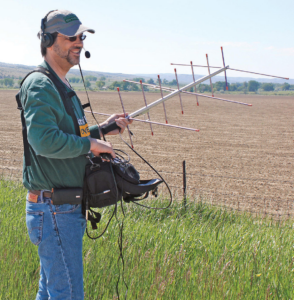
Analog Transponders
ARRL rules apply, except:
Each phone, CW, and digital segment ON EACH SATELLITE TRANSPONDER is considered to be a separate band.
CW and digital (FT-4, RTTY, PSK-31, etc.) contacts count THREE points each.
Stations may only count one (1) completed QSO on any single channel FM satellite. If a satellite has multiple modes such as V/u and L/s modes both turned on, one contact each is allowed. If the both ISS stations are operational, one QSO on each mode (1 phone and 1 digital), Contacts with the ISS crew will count for one contact if they are active. Greencube (1 digital).
The use of more than one transmitter at the same time on a single satellite transponder is prohibited.
Digital Transponders
Satellite digipeat QSO’s and APRS short-message contacts are worth three points each, but must be complete verified two-way exchanges. The one contact per FM satellite is not applied to digital transponders.
The use of terrestrial gateway stations or internet gateways (i.e. EchoLink, IRLP, etc.) to uplink/downlink is not allowed.
For ‘Store and Forward’ hamsats, each satellite is considered a separate band. Do not post “CQ” messages. Simply upload ONE greeting message to each satellite and download as many greeting messages as possible from each satellite. The subject of the uploaded file should be posted as Field Day Greetings, addressed to ALL. The purpose of this portion of the competition is to demonstrate digital satellite communications to other Field Day participants and observers. Do not reply to the Field Day Greetings addressed to ALL.
The following uploads and downloads count as three-point digital contacts.
(a) Upload of a satellite Field Day Greetings file (one per satellite).
(b) Download of Satellite Field Day Greetings files posted by other stations. Downloads of non-Field Day files or messages not addressed to ALL are not to be counted for the event. Save DIR listings and message files for later “proof of contact.”
You may make contacts with GreenCube, IO-117, and each one will count as 3 points as do other digital contacts.
Please note AMSAT uploaded messages do not count for QSO points under the ARRL rules.
Sample Satellite Field Day Greetings File:
KK5DO FD EL29 class 2A 20 participants
Note that the message stated the call, operating class, where they were located (the grid square) and how many operators were in attendance.
Operating Class
Stations operating portable and using emergency power (as per ARRL Field Day rules) are in a separate operating class from those at home connected to commercial power. On the report form simply check off Emergency or Commercial for the Power Source and be sure to specify your ARRL operating class (2A, 1C, etc.).
AND FINALLY…
The Satellite Summary Sheet should be used for submission of the AMSAT Field Day competition and be received by KK5DO (e-mail) by 11:59 P.M. CDT, Monday, July 23, 2024. This year, we are using the same due date as the ARRL. The only method for submitting your log is via e-mail to [email protected] or [email protected]. I have not had a mail-in entry in a very long time.
Add photographs or other interesting information that can be used in an article for the Journal.
You will receive an e-mail back (within one or two days) from me when I receive your e-mail submission. If you do not receive a confirmation message, then I have not received your submission. Try sending it again or send it to my other e-mail address.
Certificates will be awarded for the first-place emergency power/portable station at the AMSAT General Meeting and Space Symposium in the fall of 2024. Certificates will also be awarded to the second and third place portable/emergency operation in addition to the first-place home station running on emergency power. A station submitting high, award-winning scores will be requested to send in dupe sheets for analog contacts and message listings for digital downloads.
You may have multiple rig difficulties, antenna failures, computer glitches, generator disasters, tropical storms, and there may even be satellite problems, but the goal is to test your ability to operate in an emergency situation. Try different gear. Demonstrate satellite operations to hams that don’t even know the HAMSATS exist. Test your equipment. Avoid making more than ONE contact via the FM-only voice HAMSATS or the ISS, and enjoy the event!
[ANS thanks Bruce Paige, KK5DO, AMSAT Director Contests and Awards, AMSAT Board Member 2016-2024 for the above information.]
Want to fly the colors on your own grid expedition?
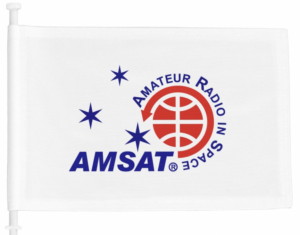
Get your AMSAT car flag and other neat stuff from our Zazzle store!
25% of the purchase price of each product goes towards
Keeping Amateur Radio in Space
https://www.zazzle.com/amsat_gear
Changes to AMSAT-NA TLE Distribution for June 14
Two Line Elements or TLEs, often referred to as Keplerian elements or keps in the amateur community, are the inputs to the SGP4 standard mathematical model of spacecraft orbits used by most amateur tracking programs. Weekly updates are completely adequate for most amateur satellites. TLE bulletin files are updated daily in the first hour of the UTC day. New bulletin files will be posted immediately after reliable elements become available for new amateur satellites. More information may be found at https://www.amsat.org/keplerian-elements-resources/.
No changes reported this week.
[ANS thanks AMSAT Orbital Elements page for the above information]
ARISS NEWS
Amateurs and others around the world may listen in on contacts between amateurs operating in schools and allowing students to interact with astronauts and cosmonauts aboard the International Space Station. The downlink frequency on which to listen is 145.800 MHz worldwide.
Postponed until fall 2024.:
Instituto de Aplicação Fernando Rodrigues da Silveira (CAp-UERJ) and The State University of Rio de Janeiro (UERJ), Rio de Janeiro, Brazil, direct via PY1AX
The ISS callsign is presently scheduled to be NA1SS
The scheduled crewmember is Jeanette Epps, KF5QNU. The ARISS mentor is VE3TBD.
Contact is postponed until fall 2024.
The crossband repeater continues to be active (145.990 MHz up {PL 67} & 437.800 MHz down). If any crewmember is so inclined, all they have to do is pick up the microphone, raise the volume up, and talk on the crossband repeater. So give a listen, you just never know.
The packet system is also active (145.825 MHz up & down). The HamTV and SSTV systems are currently stowed.
As always, if there is an EVA, a docking, or an undocking; the ARISS radios are turned off as part of the safety protocol.
Note, all times are approximate. It is recommended that you do your own orbital prediction or start listening about 10 minutes before the listed time.
The latest information on the operation mode can be found at https://www.ariss.org/current-status-of-iss-stations.html
The latest list of frequencies in use can be found at https://www.ariss.org/contact-the-iss.html
[ANS thanks Charlie Sufana, AJ9N, one of the ARISS operation team mentors for the above information]
Upcoming Satellite Operations
KØJM will attempt to put the EN47/EN48 gridline on the air on Wednesday, June 19. Watch hams.at for details.
A growing number of satellite rovers are currently engaged in sharing their grid square activations on https://hams.at. By visiting the website, you gain easy access to comprehensive information about the operators responsible for activating specific grid squares. Additionally, you have the ability to assess the match score between yourself and a particular rover for a given pass, while also being able to identify the upcoming satellite passes that are accessible from your location.
[ANS thanks Ian Parsons, K5ZM, AMSAT rover page manager, for the above information]
AMSAT Ambassador Activities
AMSAT Ambassadors provide presentations, demonstrate communicating through amateur satellites, and host information tables at club meetings, hamfests, conventions, maker faires, and other events.
July 20, 2024
“Moon Day” Frontiers of Flight Museum
Love Field in Dallas, Texas
AMSAT volunteers needed! Contact tschuessler(at) amsat.org for more information.
August 17-18, 2024
Huntsville Hamfest
Huntsville, AL
AMSAT Booth and Forum
N8DEU and W4FCL
September 7, 2024
Greater Louisville Hamfest
Shepherdsville, KY
AMSAT Forum and Information Table
W4FCL
October 5, 2024
Central Kentucky Hamfest
Lexington, KY
AMSAT and Educational Satellites Forum and Information Table
AI4SR and W4FCL
October 5, 2024
North Star Radio Convention
Hennepin Technical College (North Campus)
Brooklyn Park, Minn.
AMSAT Forum and Information Table
KØJM and ADØHJ
[ANS thanks the AMSAT Events page for the above information]
Satellite Shorts From All Over
+ The U.S. spacewalk 90 planned for Thursday, June 13 at the International Space Station did not proceed as scheduled due to a spacesuit discomfort issue. NASA astronauts Tracy C. Dyson and Matthew Dominick, KCØTOR, completed taking off their spacesuits about an hour before the crew was anticipated to exit the Quest airlock. With consideration to NASA’s Boeing Crew Flight Test and other spaceflight operations, the next spacewalk will be Monday, June 24, followed by another on Tuesday, July 2, as was previously planned. The June 24 spacewalk will focus on radio frequency group hardware removal, while the content of the July 2 spacewalk is under evaluation and will be shared as available. The crew members on the station are healthy, and spacesuits are functioning as expected. [As always, if there is an EVA, a docking, or an undocking; the ARISS radios are turned off as part of the safety protocol. ANS thanks NASA for the above information.]
+ AMSAT-DL is organizing a symposium, flea market and general meeting in the radome of the Bochum Observatory, Germany on September 20-22, 2024. The radome will once again be dedicated to satellite and space research. AMSAT Deutschland e.V. and the Bochum Observatory are taking the positive experience of the anniversary conference in 2023 as an opportunity to inform AMSAT members and other space enthusiasts about current and future prospects for national and international space projects with a varied program. As the Radom is also the location of ESA’s education office in Germany (esero Germany), a goal is to make the symposium even more attractive in future and at the same time focus even more on current European space travel. [ANS thanks AMSAT-DL for the above information.]
+ SpaceX’s enormous rocket took off again from South Texas on June 6, this time with the sole goal of bringing both the booster and ship softly back to Earth in (roughly) single pieces. An on-time launch of the world’s most powerful rocket delivered excitement from start to finish. Despite an engine out on launch and landing (with 33 engines total, Superheavy doesn’t care), the first stage was able to complete a nominal ascent, hot-staging, temporary hot-staging ring jettison, boost back, and landing burn—all with enough precision that previously deployed buoy cams were able to capture its soft splashdown. [ANS thanks The Orbital Index for the above information.]
+ Russian cosmonaut and ISS commander Oleg Konenko became the first person to reach 1,000 cumulative days in space as of June 4. The milestone comes amid his fifth flight to space and during his third stint as the commander of the ISS. His most recent trip to the orbiting laboratory began with a launch aboard the Soyuz MS-24 spacecraft on Sept. 15, 2023, alongside cosmonaut Nikolai Chub and NASA astronaut Loral O’Hara, KI5TOM. He’s scheduled to return with Chub and NASA astronaut Tracy Dyson in September 2024. [ANS thanks Spaceflight Now for the above information.]
Join AMSAT today at https://launch.amsat.org/
In addition to regular membership, AMSAT offers membership to:
* Societies (a recognized group, clubs or organization).
* Primary and secondary school students are eligible for membership at one-half the standard yearly rate.
* Post-secondary school students enrolled in at least half time status shall be eligible for the student rate for a maximum of 6 post-secondary years in this status.
* Memberships are available for annual and lifetime terms.
Contact info [at] amsat.org for additional membership information.
73 and remember to help Keep Amateur Radio in Space!
This week’s ANS Editor, Mark Johns, KØJM
k0jm [at] amsat.org
